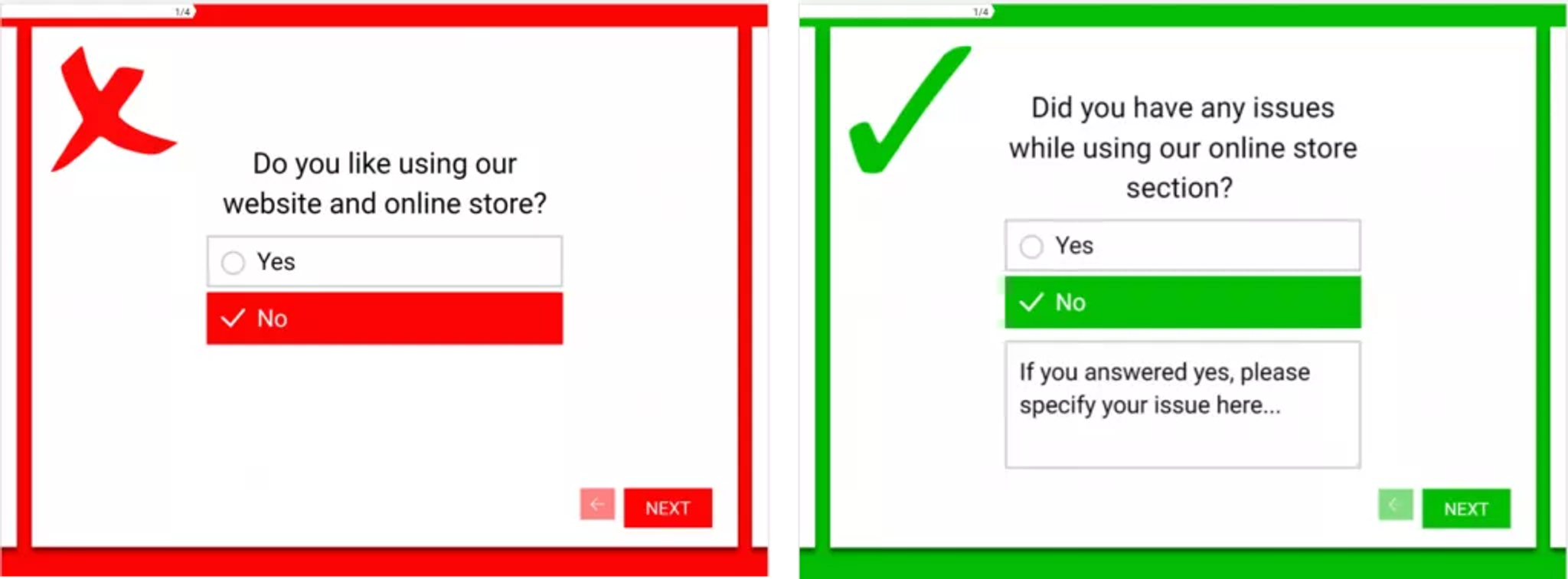Discover why UX surveys are essential for gathering feedback and improving user experience. Learn how to conduct UX surveys to extract meaningful and actionable insights that can refine your design and meet user needs. In today’s digital world, UX is crucial for a product’s success.
It focuses on usability, accessibility, and delight, shaping how users interact with services. Good UX boosts satisfaction, builds loyalty, and drives repeat business. To stay competitive, companies must prioritize exceptional user experiences.
UX surveys help businesses understand user needs and behaviors, connecting customers and developers with actionable insights. By analyzing this data, businesses can exceed expectations and create more intuitive, engaging experiences. For digital success, embracing UX is a must.
What Is a UX Survey?
UX surveys are designed to encapsulate customers’ feedback on their experience with a product or a service. These surveys come with quantitative and qualitative elements so that users can sell input through opinions, ratings, or suggestions for improvement. It is important to use simple language to avoid confusing survey participants.
These surveys focus on usability, feature satisfaction, and the user’s general impression of the system’s interface. UX Surveys are also helpful in tracking metrics over time, allowing companies to assess whether changes made in interface updates were beneficial to the user.
Source: uxsurvey

The Importance of UX Surveys
UX surveys are an effective way to get relevant insights straightforwardly and intuitively. They allow users to state their preferences and highlight areas where they face problems.
A channel through which well-justified improvements can be made uses an innovative UX survey. UX surveys can also be used to measure and improve customer satisfaction by designing and implementing structured methodologies like the Customer-Satisfaction Score (CSAT).
There is also the issue of design validation. UX surveys are crucial in developing user-centric thinking and creating a far-reaching impact. Successful, intuitive, and pleasant interactions can only be provided through thorough UX survey analysis, whether launching a brand-new product or fine-tuning existing ones.
Types of UX Surveys
The recognition of diverse UX survey types is critical to companies that want to obtain valuable user input and stay competitive in the current market. Each type has its own purpose and yields insights targeted at specific goals, which empowers industries to develop their products better.
Understanding and implementing various survey methods in UX research is essential for both evaluative and generative purposes, ensuring structured and actionable data collection.
Longitudinal surveys
Longitudinal surveys are carried out over an extended period, allowing researchers to collect records at multiple periods. This method aids in determining traits and shifts in user conduct, preferences, and reports over weeks, months, or maybe years. Longitudinal surveys are a specific research method used to gather user insights over time.
Through statistics analysis, researchers can identify styles indicative of changing consumer wishes or examine the success of modifications made in reaction to preceding feedback. Longitudinal surveys are particularly valuable for information on long-term effects and the iconic effects of interventions.
Source: fastercapital

Cross-sectional surveys
Cross-sectional surveys accumulate information from a selected user institution at an unmarried time. These surveys are instrumental in taking pictures, a snapshot of a person’s sentiments and behaviors, informing design decisions, or assessing an ordinary person’s pleasure at a given moment. Cross-sectional surveys often use quantitative surveys to gather data.
Evaluating those responses lets businesses ascertain the contemporary state of personal pleasure and pinpoint immediate regions for enhancement. Market studies often employ cross-sectional surveys to establish a baseline knowledge of winning user perceptions.
Pulse surveys
Pulse surveys consist of quick, frequent surveys that capture instant comments on unique elements of the consumer experience. Typically quick to complete, with only a few questions, they may be used to gauge user sentiment following updates or changes to a product or feature.
Pulse surveys allow organizations to immediately grasp their consumer base’s on-the-spot reactions, facilitating fast modifications and refinements to beautify personal satisfaction and experience. Additionally, pulse surveys provide valuable data for immediate feedback.
In-app surveys
In-app surveys are integrated within the utility, offering a handy mechanism for customers to provide feedback while enticing with the product. These instantaneous remarks are priceless for know-how context-particular consumer reports and improving usability.
In-app surveys frequently present as pop-ups or notifications, inviting customers to share their insights with minimal disruption to their experience. This technique provides real-time insights into consumer interactions with specific features, contributing to their typical pride.
Source: Akwatoria

Transactional surveys
Transactional surveys are administered following a specific interaction or transaction, including finishing a buy or receiving customer support. These surveys focus on the person's experience all through that interplay, offering insights into delight levels and areas for improvement.
Transactional surveys can perceive particular strengths or ache points inside the user adventure, allowing companies to put into effect targeted improvements that improve the overall client experience and foster loyalty.
UX Survey Questions
Gathering feedback is key to improving user experiences. Use these UX survey questions to better understand your users’ needs and preferences. Well-designed user survey questions are crucial for obtaining valuable insights.
Types of UX Survey Questions
Single-select Questions
- Use dropdown menus for lists where participants pick only one option.
- Radio buttons are great for simple questions like "Yes/No"
Multi-select Questions
- Adapt other question types for multi-select, like selecting multiple images or items from a dropdown.
- Checkboxes work well for short lists and let users pick multiple answers.
Open Text Fields
- Use open text fields for flexible input, such as contact forms.
- Short and long text boxes let participants give detailed answers.
- Add identity verification fields like phone numbers or emails to filter bots.
Rating Scales and Grids
- Sliding bars let users visually rate by dragging along a scale. Make sure anchors are labeled and scales are uniform if using multiple.
- Radio button grids efficiently collect multiple responses, perfect for repeating similar questions or evaluating different items.
Source: lyssna

Learn UX Survey Best Practices
Following these established, best practices are essential to optimizing the effectiveness of UX surveys. The importance of user research in designing effective UX surveys cannot be overstated. Here are a few main points to consider.
Maintain Conciseness and Focus
An organized survey should have a few questions. Instead, it should be brief but concise. This results in more responses, as users are usually willing to finish shorter surveys without getting bored.
Critical questions will be highlighted, and irrelevant complexities that might discourage respondents from completing the study will be avoided.
Blend Quantitative and Qualitative Questions
Combining both types of questions achieves an all-inclusive understanding of user experiences. For example, quantitative questions offer measurable figures concerning user activities, such as satisfaction ratings or task durations on specific sites.
Conversely, qualitative issues provide deeper qualitative insights into emotions and reasons by exploring feelings about the subject matter at hand or the motivation behind the user's interactions and actions.
Open-ended queries allow individuals to express themselves using their terminologies, which refines feedback further by bringing out underlying concerns or creative suggestions that numerals cannot show.
Source: toladata

Qualitative Survey Examples
Qualitative surveys collect data on how people perceive and experience the world. In business, they help companies understand how consumers interact with products, services, and brands. By exploring behaviors and motivations, businesses gain insights into customer opinions and actions.
The goal of qualitative surveys is to uncover what people think and why. Using in-depth questions, often inspired by psychology and sociology, these surveys explore feelings and motivations. For businesses, this data provides valuable insights into customer decision-making and helps brands connect on a personal level.
Methods include observation, ethnography, and case studies, but businesses mainly use interviews and surveys to gather qualitative data.

Quantitative Survey Examples
Quantitative research gathers numerical data using methods like rating scales or ranking questions. It may also include open-ended questions, where responses are coded into numbers for analysis.
A key benefit of quantitative research is its support for statistical analysis, unlike qualitative methods like focus groups or interviews. Surveys often use close-ended questions, providing clear, actionable insights.
Paired with open-ended responses, they offer a more complete understanding by combining structured data with deeper context.This article explores quantitative research and survey question types.
Source: quantilope

Analyzing and Acting on Survey Data
Analyzing survey data transcends simple number crunching—it involves deeply understanding your users' feedback and translating their insights into meaningful improvements. Here's how this process can be viewed through a professional lens:
Utilizing UX Survey Tools
UX survey tools are essential for gathering user feedback and improving the overall user experience of your product or service. These tools help you collect valuable insights directly from your audience, uncovering pain points, preferences, and behaviors.
By using features like customizable questionnaires, real-time analytics, and user segmentation, you can make data-driven decisions to refine your design and functionality. Whether you’re launching a new feature or enhancing an existing one, leveraging a UX survey tool ensures that your product aligns with user needs and expectations.
Identifying Patterns and Trends
Analyzing feedback is akin to investigative work, where the goal is to discern overarching trends rather than focusing solely on individual comments.
For example, a recurring complaint about a specific feature or a notable increase in positive feedback following an update can reveal critical insights.
By monitoring these patterns over time, organizations can proactively address potential issues before they escalate and reinforce the aspects of their offerings that resonate with users.
Translating Insights into Action
The actual value of data analysis is realized when insights lead to concrete actions. Organizations must take these findings - those "Aha!" moments - and implement visible, meaningful changes that directly address user feedback.
This could involve resolving persistent bugs or incorporating frequently requested features. The essence of this approach is demonstrating to users that their input is valued and acted upon, which fosters a sense of trust and loyalty.
Source: Unsplash+

Challenges and Limitations
Collecting feedback through surveys is an excellent manner to understand what your customers need and want, but it comes with challenges. Tackling those demanding situations head-on is crucial in collecting valuable insights that result in real enhancements:
Survey Fatigue
If users are continuously asked to complete surveys, they could quickly get uninterested in them, leading to fewer responses and decreased-quality comments. When bombarded with too many requests, people might rush through their solutions, provide incomplete responses, or ignore the surveys.
This can skew your records. To avoid this, planning survey timing and frequency is important. Ensure each look has a clean cause and is as quick and applicable as feasible. Also, letting users understand how their remarks have been used can inspire them to participate in destiny surveys.
Source: medium

Bias in Responses
Bias can creep into surveys in specific ways. Poorly worded questions or ones that advise a particular solution can produce skewed outcomes. There's also the problem of self-choice bias, where certain sorts of users - usually people with robust opinions - take part, which won't replicate the views of your broader person base.
To lessen bias, it is essential to lay out surveys using impartial language, encompass numerous query kinds leading questions, and make sure that your sample represents your typical target audience. Testing the take a look at a small institution first and using random sampling strategies also can help get more balanced responses.
The Future of UX Surveys
A pivotal aspect of UX surveys' destiny is their seamless integration with other UX research methods and strategies. Corporations can benefit from a holistic view of user satisfaction by combining surveys with usability testing, user interviews, and analytics.
This approach allows for triangulation, in which numerous facts and resources validate one another, resulting in deeper insights and extra knowledgeable decision-making.
By cross-referencing findings from diverse research methodologies, companies can construct comprehensive information on consumer interactions and challenges, refining their techniques with precision.
In this dynamic environment, UX surveys will guide corporations toward more consumer-centered layouts and improvement strategies, ultimately enhancing client satisfaction and loyalty.
Source: Akwatoria

Read more:
Conclusion
As UX research evolves, integrating AI and system studying will increase the effectiveness of surveys. These technologies allow advanced data analysis and fashion identification, leading to actionable feedback.
A facts-driven method allows organizations to live agile and attentive to personal expectancies, fostering stronger patron relationships and enterprise achievement.
Now is the time for agencies to implement powerful UX survey techniques to steer in user-focused design, improve merchandise, and build a faithful consumer base.


About Clay
Clay is a UI/UX design & branding agency in San Francisco. We team up with startups and leading brands to create transformative digital experience. Clients: Facebook, Slack, Google, Amazon, Credit Karma, Zenefits, etc.
Learn more

About Clay
Clay is a UI/UX design & branding agency in San Francisco. We team up with startups and leading brands to create transformative digital experience. Clients: Facebook, Slack, Google, Amazon, Credit Karma, Zenefits, etc.
Learn more


